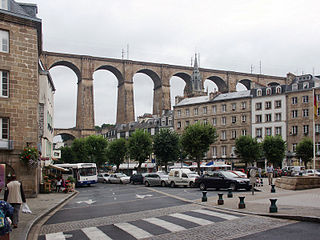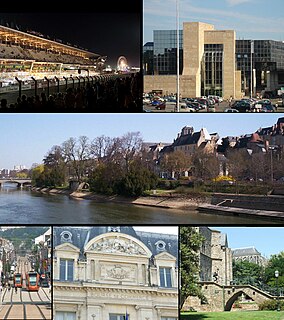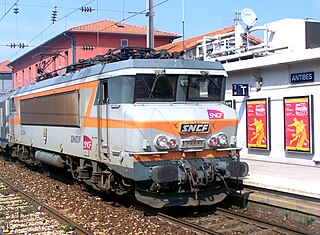
The Trans Europ Express, or Trans-Europe Express (TEE), is a former international first-class railway service in western and central Europe that was founded in 1957 and ceased in 1995. At the height of its operations, in 1974, the TEE network comprised 45 trains, connecting 130 different cities, from Spain in the west to Austria in the east, and from Denmark to Southern Italy.
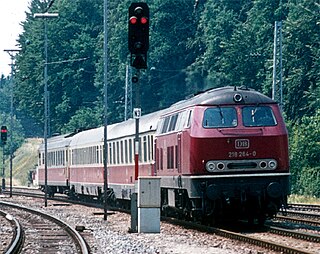
The Bavaria was an express train that linked München Hbf in Munich, Germany, with Zürich HB in Zurich, Switzerland. Introduced in the 1950s, it ran through to Geneva until 1969, when it was cut back to Zurich. The train was named on the basis that Bavaria is the Latin equivalent to the German word Bayern, the official name of the federal state of Bavaria, of which Munich is the capital. It was operated by the Deutsche Bundesbahn / Deutsche Bahn (DB) and the Swiss Federal Railways (SBB-CFF-FFS). The route also included a single stop in Austria, at Bregenz. The 24 km (15 mi) section between Lindau, Germany, and St. Margrethen, Switzerland, is located mostly in Austria, but Swiss locomotives hauled the train over this section, most of which is part of the Vorarlberg line of Austrian Federal Railways.

The Arbalète was an express train that linked Paris-Est in Paris, France, with Zürich HB in Zurich, Switzerland. Introduced in 1957, it was operated by the SNCF and the Swiss Federal Railways (SBB-CFF-FFS).

The Cisalpin was an express train that linked Paris-Gare de Lyon in Paris, France, with Milano Centrale in Milan, Italy. Introduced in 1961, it was operated by the SNCF, the Swiss Federal Railways (SBB-CFF-FFS) and the Italian State Railways (FS).

Le Mistral, or the Mistral, was an express train between Paris and Nice in France. Introduced in 1950, it was operated by the Société Nationale des Chemins de fer français (SNCF), and was regarded as the company's flagship train.

The Albert Schweitzer was a short-lived express train that linked Dortmund Hbf in Dortmund, Germany, with Strasbourg-Ville in Strasbourg, France. Introduced in 1980, it was operated by the Deutsche Bundesbahn (DB) and the SNCF.

Le Capitole was an express train between Paris and Toulouse in France. Introduced in 1960, it was operated by the Société Nationale des Chemins de fer français (SNCF). It was also the SNCF’s first foray into high-speed commercial service above 160 km/h (99 mph).

The Étoile du Nord was an international express train. It linked Paris Nord in Paris, France, with Brussels, Belgium, and, for most of its existence, also with Amsterdam CS in Amsterdam, the Netherlands. Its name meant literally "Star of the North", and alluded not only to its route heading north from Paris, but also to one of its original operators, the Chemin de Fer du Nord.

The word Mediolanum has been used to name three distinct international express trains that have run to and from Milano Centrale in Milan, Italy since 1957. The focus of these trains on the city now known as Milan reflects the fact that Mediolanum is the Latin word for ancient Milan.

Kléber was an express train that linked Strasbourg and Paris, France, between 1971 and 1988. It was a first-class-only Trans Europ Express (TEE) operated by the Société Nationale des Chemins de fer français (SNCF).

Stanislas was an express train that linked Paris and Strasbourg in France. Introduced in 1971, it was operated by the Société Nationale des Chemins de fer français (SNCF).
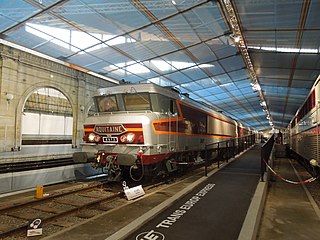
The Aquitaine was an express train that linked Bordeaux and Paris, France, between 1971 and about 1990. Operated by the Société Nationale des Chemins de fer français (SNCF), it was a first-class-only Trans Europ Express (TEE) until 1984 and then a two-class Rapide until discontinued, circa 1990.
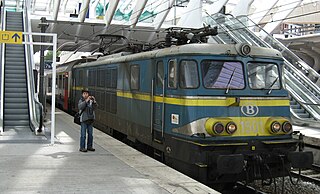
The Brabant was an express train that linked Gare du Nord in Paris, France, with Brussels-South in Brussels, Belgium. The train was named after the historical Duchy of Brabant of which Brussels was the capital.

The Île de France was an international express train on the PBA route (Paris-Brussels-Amsterdam). The train was named after the French region surrounding Paris.
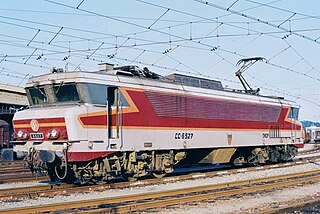
The Étendard was an express train that linked Paris and Bordeaux in France. Introduced in 1968, it was operated by the Société Nationale des Chemins de fer français (SNCF), and was initially a Rapide.

Le Lyonnais, or the Lyonnais, was an express train that linked Paris and Lyon in France. Introduced in 1968, it was operated by the Société Nationale des Chemins de fer français (SNCF). The train is named after the geographical area known as the Lyonnais, a historical (former) French province, whose name came from the city of Lyon.

Le Rhodanien, or the Rhodanien, was an express train with its southern terminus in Marseilles, France. Operated by the Société Nationale des Chemins de fer français (SNCF), it was named using the French language adjective derived from the Rhone river; the name alludes, amongst other things, to the river, its valley, and the dialect of the Franco-Provençal language that is spoken there.

The Watteau was an express train that linked Gare du Nord in Paris, France, with Tourcoing in the North of France. The train was named after the French painter Antoine Watteau.
The Gayant was an express train that linked Gare du Nord in Paris, France, with Tourcoing in the department of Nord, also in France. The train was named after Gayant, the processional giant of Douai, France.
The Faidherbe was an express train that linked Gare du Nord in Paris, France, with Lille in the North of France. The train was named after the Lille born governor of Senegal, General Louis Faidherbe.






